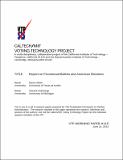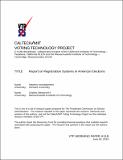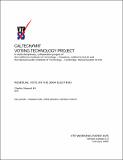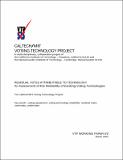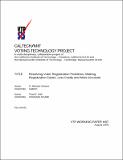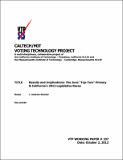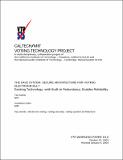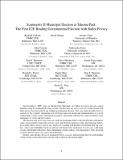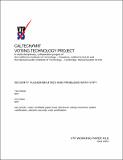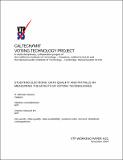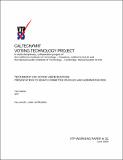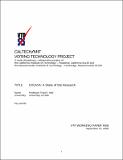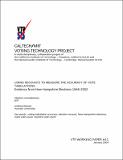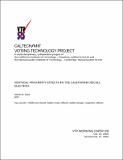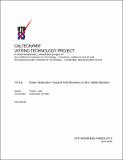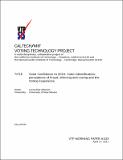Browsing Voting Technology Project by Title
Now showing items 81-100 of 125
-
Report on Provisional Ballots and American Elections
(Caltech/MIT Voting Technology Project, 2013-06-21)Both empirical and anecdotal data indicate that the use of provisional ballots in U.S. elections is a mixed bag. On the one hand, providing voters whose eligibility is unclear with an opportunity to cast a provisional ... -
Report on Registration Systems in American Elections
(Caltech/MIT Voting Technology Project, 2013-06-26)Voter registration systems are the backbone of election administration in the United States today. These lists facilitate the operation of elections at the precinct level, communications by election officials and candidates ... -
Research Note on Footnote 24 of the 6th Circuit Hunter Decision
(Caltech/MIT Voting Technology Project, 2011-02-03)The decision issued by the three-judge panel of the 6th Circuit Court of Appeals in the matter of Hunter v. Hamilton County Board of Elections contains a very interesting analysis of problems with Ohio’s law about counting ... -
Residual Vote in the 2004 Election
(Caltech/MIT Voting Technology Project, 2005-02-07)In 2000 Americans learned that their elections are not always run according to the highest standards. This revelation led to two major developments. The first was a flurry of election reform activity at the state and ... -
Residual Votes Attributable to Technology: An Assessment of the Reliability of Existing Voting Equipment
(Caltech/MIT Voting Technology Project, 2001-03-30)American elections are conducted using a hodge-podge of different voting technologies: paper ballots, lever machines, punch cards, optically scanned ballots, and electronic machines. And the technologies we use change ... -
Resolving Voter Registration Problems: Making Registration Easier, Less Costly and More Accurate
(Caltech/MIT Voting Technology Project, 2009-08)The practice of voter registration has a long history in the United States. In 1800, Massachusetts was the first state to impose a voter registration requirement. By Reconstruction, voter registration was used in a handful ... -
Results and Implications: The June "Top-Two" Primary & California's 2012 Legislative Races
(Caltech/MIT Voting Technology Project, 2012-11-02)This report summarizes some basic results of California’s June 2012 “Top-Two” primary. It focuses on legislative offices with multiple districts within the state: California State Assembly, California State Senate, and ... -
The SAVE System: Secure Architecture for Voting Electronically: Existing Technology, with Built-in Redundancy, Enables Reliability
(Caltech/MIT Voting Technology Project, 2004-01-04)Existing technology is capable of yielding secure, reliable, and auditable voting systems. This system outlines an architecture based on redundancy at each stage of the ballot submission process that is resistant to external ... -
Scantegrity II Municipal Election at Takoma Park: The First E2E Binding Governmental Election with Ballot Privacy
(Caltech/MIT Voting Technology Project, 2010-02-01)On November 3, 2009, voters in Takoma Park, Maryland, cast ballots for mayor and city council members using the ScantegrityII voting system—the first time any end-to-end (e2e) voting system with ballot privacy has been ... -
Scantegrity Responds to Rice Study on Usability of the Scantegrity II Voting System
(Caltech/MIT Voting Technology Project, 2014-12-28)This note is a response to, and critique of, recent work by Acemyan, Kortum, Bryne, and Wallach regarding the usability of end-to-end verifiable voting systems, and in particular, to their analysis of the usability of the ... -
Security Vulnerabilities and Problems with VVPT
(Caltech/MIT Voting Technology Project, 2004-04)A proposed Voter Verifiable Paper Trail (VVPT) includes a printed ballot as a receipt that a voter can view to verify their vote before leaving an electronic voting machine. This method is also supposed to insure the ... -
Study Shows Ballot Design and Voter Preparation Could Have Eliminated Sarasota Florida Voting Errors
(Caltech/MIT Voting Technology Project, 2008-02-06)Election results showed extremely inconsistent voting rates for two high profile races in the Florida counties of Sarasota, Charlotte, and Sumter on November 7, 2006. The expected missing selections for these races were ... -
Studying Elections: Data Quality and Pitfalls in Measuring the Effects of Voting Technologies
(Caltech/MIT Voting Technology Project, 2004-11)Professor Geralyn Miller reminds us of the range of voting administration practices across the United States. We use this variability to study the average performance of various types of voting equipment throughout the ... -
Testimony on Voter Verification
(Caltech/MIT Voting Technology Project, 2005-06-21)In the past five years, following the 2000 Florida election fiasco, the voting technologies used in the United States have undergone a significant change. The use of direct recording electronic (DRE) voting machines has ... -
The ThreeBallot Voting System
(Caltech/MIT Voting Technology Project, 2006-10-01)We present a new paper-based voting method with interesting security properties. The attempt here is to see if one can achieve the same security properties of recently proposed cryptographic voting protocols, but without ... -
UOCAVA: A State of the Research
(Caltech/MIT Voting Technology Project, 2008-09-15)The problems faced by overseas civilians, military personnel, and their dependents—individuals covered by the Uniformed and Overseas Citizens Absentee Voting Act (UOCAVA)—have existed since the nation’s founding. From the ... -
Using Recounts to Measure the Accuracy of Vote Tabulations: Evidence from New Hampshire Elections 1946-2002
(Caltech/MIT Voting Technology Project, 2004-01)The 2000 presidential election exposed a surprisingly high level of inaccuracy in the tabulation of ballots. Differences between total vallots cast and votes counted were as high as 19 percent in some counties in Florida, ... -
Vertical Proximity Effects in the California Recall Election
(Caltech/MIT Voting Technology Project, 2003-10-27)The 2003 California recall election provides a unique opportunity to assess the impact of variations in ballot design and voting methods on the voting accuracy of citizens. Analysis of the results of the California Recall ... -
Voter Attitudes Toward Poll Workers in the 2008 Election
(Caltech/MIT Voting Technology Project, 2009-04)At a conference on election reform held by the National Academies of Science in 2004, Indiana’s Secretary of State, Todd Rokita, referred to poll workers as “the street level lawyers” of elections. The reason for his ... -
Voter Confidence in 2010: Voter Identification, Perceptions of Fraud, Winning and Losing and the Voter Experience
(Caltech/MIT Voting Technology Project, 2011-04-17)Over the last decade, scholars of American politics have invested research time and effort into the study of election administration and election performance. These include studies onresidual vote analysis (Wand et al 2001; ...
